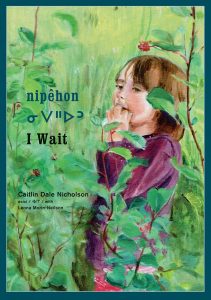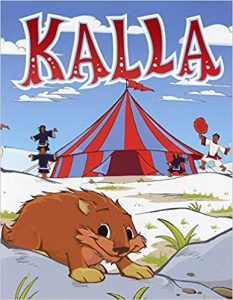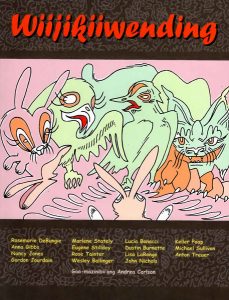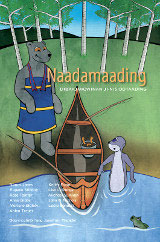United Nations Educational, Scientific and Cultural Organization (UNESCO) has officially declared 2019 as the International Year of Indigenous Languages! Across the world, UNESCO is calling for the celebration of Indigenous languages to raise awareness and appreciation for the integral role that they have in shaping cultural diversity. This month, the Indigenous Ground Floor Display features books written in several Indigenous languages spoken throughout Canada, including Anishinaabemowin, Nēhiyawēwin, Michif, Inuktitut, and Dakhótiyapi.
 Nipêhon (I Wait) by Caitlin Dale Nicholson with Leona Morin-Neilson
Nipêhon (I Wait) by Caitlin Dale Nicholson with Leona Morin-Neilson
This beautiful picture book tells the story of a young girl who is eager to pick wild yarrow for tea – but first, she must wait for her mother and grandmother. This story teaches the virtue of patience and the importance of loving your family, no matter what age you are! Nipêhon is written in both Nēhiyawēwin and English, and its colourful pages and calming pace make it a captivating choice for a young story-time audience. The book uses variations of simple sentences that reinforce Nēhiyawēwin vocabulary and sentence structure. A recipe for yarrow tea can also be found in the final pages.
 Kalla by Kelly Ward, Navarana Beveridge, Isabelle Dingemans, Gerdhardt Egede & Rosemary Meyok
Kalla by Kelly Ward, Navarana Beveridge, Isabelle Dingemans, Gerdhardt Egede & Rosemary Meyok
Inspired by the Artcirq Inuit Circus, Kalla is all about fun and games! At the circus, Kalla has one eye on the acrobats, and another on the emerging patterns and numbers that come from each new trick. Using interactive narration, Kalla will encourage readers to search, count, and move along with him! This book is written in five different Inuktitut variations – South Baffin Inuktitut, Innuinnaqtun, North Baffin Inuktitut, Greenlandic, and Kivaliq – with translations provided in both English and French. Colour-coded text and a corresponding map will help readers distinguish the form of each variation, and the areas of Nunavut and Greenland that they are spoken. Kalla’s story is best suited for an early elementary audience, but older readers will appreciate a chance to explore the different language variations.
 Wiijikiiwending by Rosemarie DeBungie [et al.] and Naadamaading : dibaajimowinan ji-nisidotaadingby Nancy Jones [et al.] – Birchbark Books
Wiijikiiwending by Rosemarie DeBungie [et al.] and Naadamaading : dibaajimowinan ji-nisidotaadingby Nancy Jones [et al.] – Birchbark Books
Written entirely in Anishinaabemowin, Wiijikiiwending is a series of stories about the culture of the Anishinanaabe. Friendship, sharing, and respect are at the heart of these stories, whose main characters are all animals. With a playful balance between artwork and text and its striking black gutters, Wiijikiwending has a sleek appearance reminiscent of a graphic novel and is suitable for older elementary or early mi ddle school readers. Naadamaading: dibaajimowinan ji-nisidotaadin is about Makoons and Nigigoons, two friends that learn about their Anishinanaabe culture through a combination of listening to their elders and embarking on their own adventures. This story is geared towards slightly younger readers, who will enjoy how its abundance of illustrations tie in with the narration. Both stories are written by Anishinanaabe first-language speakers and scholars, and Wiijikiiwending has been transcribed by second-language speakers.
ddle school readers. Naadamaading: dibaajimowinan ji-nisidotaadin is about Makoons and Nigigoons, two friends that learn about their Anishinanaabe culture through a combination of listening to their elders and embarking on their own adventures. This story is geared towards slightly younger readers, who will enjoy how its abundance of illustrations tie in with the narration. Both stories are written by Anishinanaabe first-language speakers and scholars, and Wiijikiiwending has been transcribed by second-language speakers.
This month’s display also has selections for readers interested in second language acquisition and Indigenous language research. For students looking to learn Anishinaabemowin, Learning Ojibwe : Anishinaabemowin maajaamigad, is a wonderful resource concentrating on vocabulary and syntax; telling the story of the construction of a hockey arena on Manitoulin Island, English translations are segmented vertically underneath Anishinaabemowin text and accompanied by an audio CD. For those interested in Indigenous language pedagogy, Indigenous youth and multilingualism : language identity, ideology, and practice in dynamic cultural worlds and Children’s language and multilingualism : indigenous language use at home and school are relevant reads, while Revitalizing Indigenous Languages: How to Recreate a Lost Generation is an encouraging research study about how revitalization efforts surrounding the Aanar Saami language in Finland can inspire similar efforts in other countries.
To borrow these selections and many more, please visit the Indigenous Display on the ground floor of OISE Library by the circulation desk. You are welcome to open the sliding case doors and browse, or ask a librarian for assistance!
